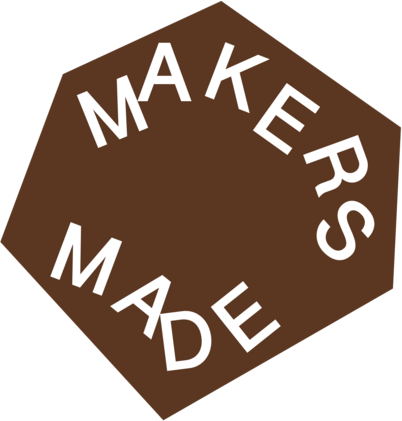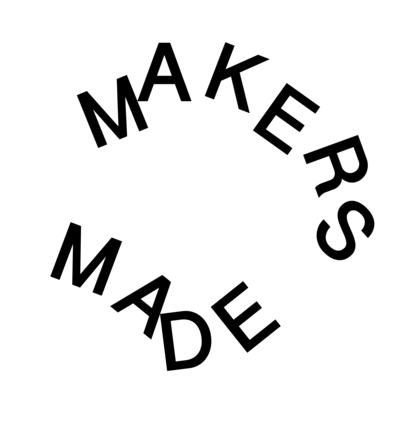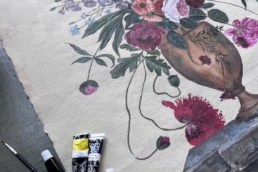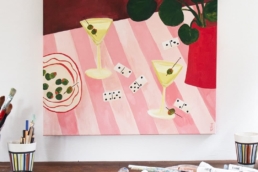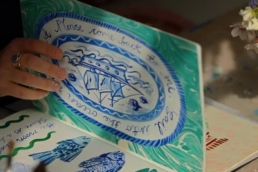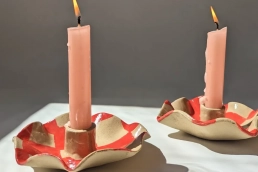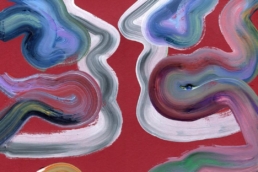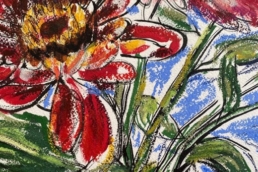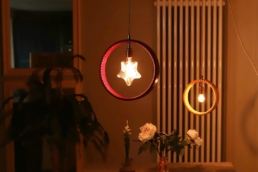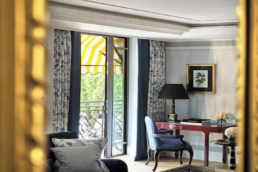In this Q&A, we talk with artist Annie Strachan about her creative journey, her bold approach to sculpture and functional art using papier-mâché, and her passion for sustainability and experimentation.
Annie shares insights into how popular culture and vintage design inspire her playful creations, the importance of balancing creative practice with wellbeing, and the exciting collaborations that have shaped her vibrant career.


1. Can you tell us a bit about yourself and your artistic journey?
I studied Fine Art at Chelsea College of Art and design, graduating in 2011. I’ve always been influenced by avant-garde furniture and interior design and it’s relationship to trends in popular culture. I started working with papier-mâché a few years ago as a means to explore more experimental forms for the production of functional sculptures.
2. What inspired you to pursue your craft? Was there a defining moment or influence that sparked your passion?
For several years, I struggled to maintain an active art practice whilst working full-time and eventually made the decision to cut my hours and devote the rest of my time to making artworks in more financially viable way. This meant realigning my thinking about art and concept driven work. I decided to reject this and take a more light hearted approach that embraces craft and the job of having a hobby.
Your craft
3. How would you describe your work in three words?
Colourful, Sustainable & Experimental
4. What materials or techniques do you use, and why are they important to your process?
I prioritise sustainable materials and techniques to minimise my carbon footprint. All of the paper and wood I use is recycled and electrical parts are sourced from UK based manufacturers.
Traditionally, I like to work at scale and am constantly changing and evolving my style so it’s important to work with low cost materials that are readily accessible. 5. Can you tell us about a favourite piece you’ve created and the story behind it? I am regularly commissioned to create unique pieces for art exhibitions and this always turns out to be some of my favourite work.
In 2024 I collaborated with Felt Collections and ceramicist Kelly Jessiman to produce an immersive artists dinner with custom furniture, lighting and ceramics. I also had the chance to collaborate with Atelier100 in 2023, producing one-off pieces for a solo installation in their West London show. Some of these very special pieces are available to buy through Makers Made.
The pinnacle of functionality is creating lighting for commercial interiors and I’m incredibly proud to have two of my lamps in daily use at the independent wine bar, Joyce in Brockley, South East London. I’ve also produced a series of unique sconces for the restaurant in the basement of Margate House Hotel and am looking forward to them opening up to the public later this year!
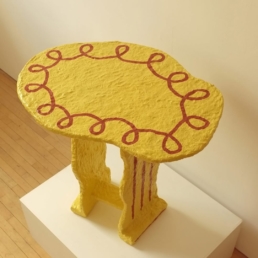
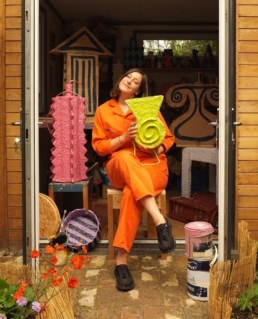
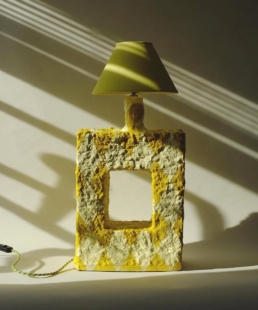
Creative process
6. What does a typical day in your studio or workshop look like?
My making process is very time consuming and occupies most of my days in the studio. I’m lucky to have a home studio where can I enjoy regular cups of tea and blasting my favourite music. I curated a regular series of playlists of some of music I like to work to and you can find these linked on my website.
Most of the materials I work with are recycled so I tend to spend a lot of time shredding paper or cleaning and cutting wood scraps to more manageable dimensions. The processes involved in working with papier-mâché to ensure pieces maintain their structure, whilst in development, require allowing plenty of time for drying between stages of making.
7. Do you have any unique rituals or habits that help you stay creative?
My rescue dog Destiny is the light of my life. Since getting her a year ago, I’ve found that the need to structure my day around healthy breaks and regular walks and cuddles helps me to stay creative. Breaking up intense or tiring days in the studio with a walk in the park is a good way to process my achievements in the studio and better manage my time. 8. How do you handle creative blocks? Do you have any strategies or tips for overcoming them?
I’ve learnt that if I’m not feeling creative or excited by a project then I just can’t push myself in that direction. It’s really important as a creative person to give yourself breaks and ensure you are looking after your physical and mental wellbeing. Normally if I’m having trouble engaging with my practice, it’s because I need to stop and allow myself to just focus on simpler more achievable goals.
Challenges and successes
9. What’s the biggest challenge you’ve faced as a maker, and how did you overcome it?
The first two years of establishing my practice were both exciting and challenging as I had the blind ambition needed to foolishly believe I’d one day be getting press attention and working with interior designers! I was also super aware of needing to prove to loved ones that my vision for a successful practice was achievable. It’s been exhausting juggling a commitment to work alongside getting something like this off the ground but I’m glad I was able to show that if I worked hard enough I could succeed, even with limited industry contacts, money or a Masters degree!
10. What’s been your proudest moment or achievement so far?
2024 was a great year for press for me, from It’s Nice That to Dezeen, but most of all, being selected by House and Garden magazine to feature in their Design 100! I’ve also had the opportunity to collaborate with incredible interior designers and curators, including Studio 2LG, L’absurde Object, Domenica Marland, Prospect Refuge and Felt Collections.
11. What’s your favourite quote you’ve ever heard about your work? Who said it, or what was the name of the publication?
“Take some techniques from slab building and woodwork, throw in some inspiration from post-war Hollywood cinema set design, and you’ve got pop sculpturist Annie Strachan.”
- It’s Nice That


Inspiration
12. Where do you draw inspiration from for your work?
What sparks your imagination and creativity? I have an obsession with archival books and magazines and often draw on imagery taken from my own collection of vintage copies of ID, Architectural Review, Domus, The Face, World of Interiors and House & Garden. I’m also lucky enough to have inherited a very special collection of 1960s & 70s interiors magazines from my Oma called Schöner Whonen which was are brilliant resource!
13. Do you have a favourite artist, maker, movement, or tradition that has influenced your craft?
I’m very inspired by popular culture in terms of music, design and more commercial forms of art. I was really into the Memphis design collective while I was studying at uni because of their thesis of producing high art/ design while referencing trash culture like kitschy retro American diners. I see a lot of that reflected in the colour palate and playfulness of my pieces.
I want my work to be chic but unpretentious and I think that’s why their aesthetic appeal was so enduring and went on to influence popular design right through the late 1980’s and 1990’s. Similarly I’m a big fan of John Waters and how important curating a style is in his early films as well as more commercial successes like, Hairspray. I remember finding a copy of the Pink Flamingos VHS in a video store when I was 16 or 17 and falling in love, I’ve been influenced ever since!
14. How does colour influence your practice; is it an important part of your process? Do you have a particular palette or favourites? Any go-to sources for colour inspiration?
Colour is extremely important to me and that’s reflected in my work but, something that may not immediately be obvious is how restrained I actually am in it’s use. I find it’s really important to balance this with how out-there the shape of pieces is
Perspectives and goals
15. What role does your environment play in shaping your creativity?
Sustainability and reducing environmental impact is key to my practice. Not only are many of the materials I use recycled or repurposed but I also source electrical parts from UK based manufacturers. My processes rely on manual labour and I don’t import parts from overseas so that the money I make goes back into supporting UK businesses like Manchester based S. Lilley & Son who supply all of my lamp holders.
16. What do you want people to feel when they experience your work?
I hope that my work is uplifting and inspires more creativity. 17. What are you currently working on, and what excites you most about it? I’ve been moving very slowly into 2025 after several years of working non-stop. I want to use this time to go back to my roots and think about showcasing my work in new environments. I’m also developing some new lamp designs which I think will be some of my cutest yet!
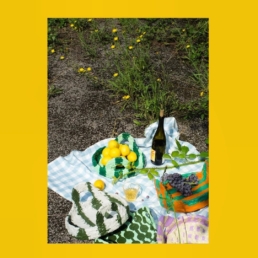
Advice and reflection
17. What advice would you give to someone starting out as a maker?
Creating is one of the most rewarding things but you need to be really thick skinned to try to make it in your own right. Remember that everyone is struggling, you just need to believe in what you’re putting out there and find your audience.
18. If you could go back to the start of your career, what advice would you give your younger self?
Don’t sacrifice your well-being in order to be a people pleaser.
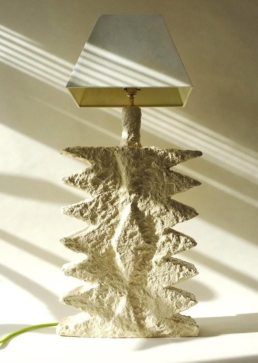
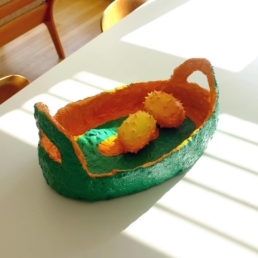
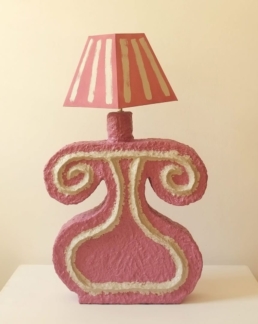
Closing thoughts
19. Where can people find your work, and how can they support you?
I have a shop on my website anniestrachan.co.uk and also sell a selection of pieces through independent retailers and galleries as If you head to my Instagram page @pulpsculptuur you’ll find links to all of these. I also exhibit regularly in gallery shows and sometimes at pop-up markets which is always a great way to meet clients face to face. These are regularly updated on my website anniestrachan.co.uk and Instagram. Thank you so much for taking the time to share your story. Once your feature is ready, we’ll send it to you to review before it goes live. After that, we’ll share it with the MAKERS MADE community and encourage you to share it with your own audience too.
Annie Strachan’s distinctive papier-mâché creations blend joyful colour, whimsical forms, and thoughtful sustainability, making functional sculptures that uplift spaces and inspire creativity. Her innovative approach and dedication to environmentally conscious design set her work apart, capturing both charm and artistic integrity.
Explore Annie’s latest collections and follow her creative journey:
Support Annie by visiting her online shop, connecting through Instagram, and experiencing her vibrant creations at exhibitions and pop-up markets.
